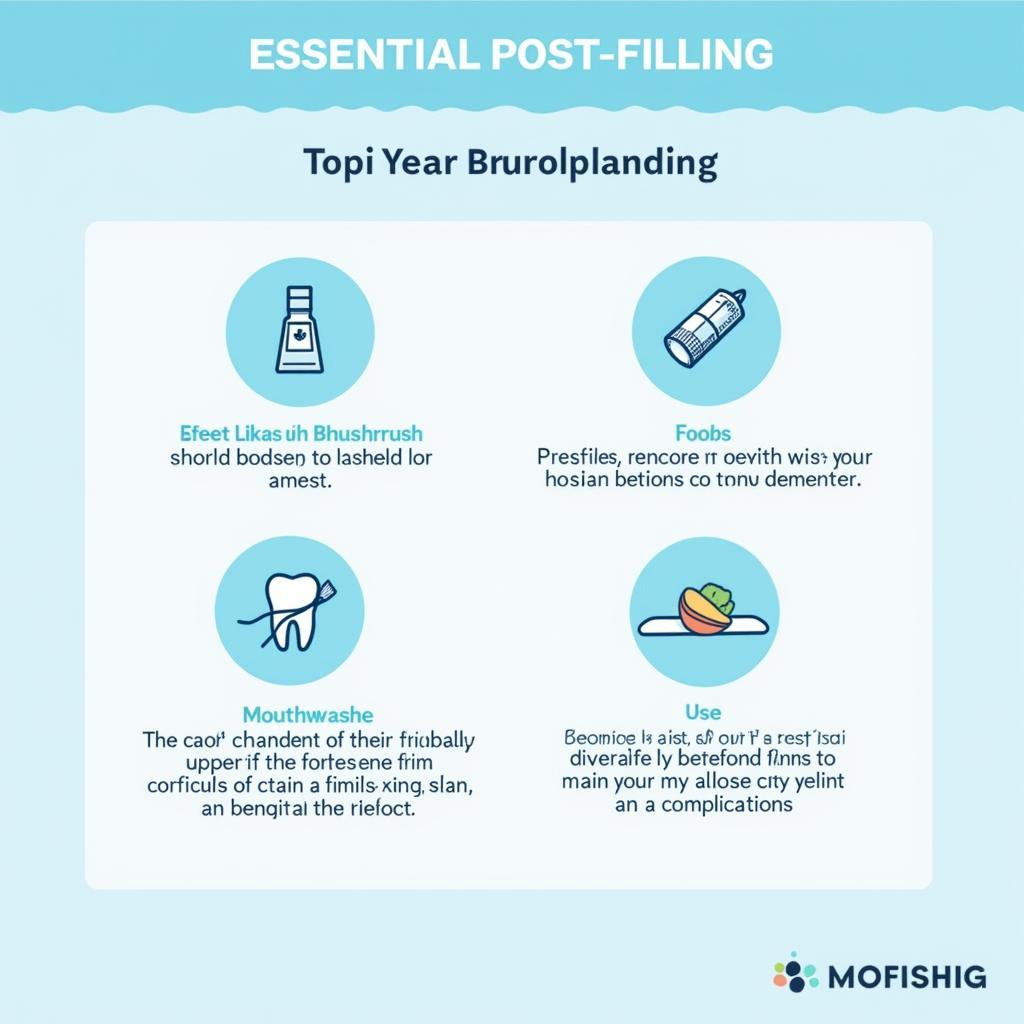After getting a filling, it’s crucial to be mindful of what you eat to ensure proper healing and prevent complications. Certain foods can dislodge the filling, cause sensitivity, or even lead to further damage. This comprehensive guide will explore the Foods To Avoid After Fillings, offering valuable insights and practical tips for a smooth recovery. Following these guidelines will help protect your newly filled tooth and maintain optimal oral health.
Why Certain Foods Should Be Avoided Post-Filling
Immediately after a filling, your tooth and the surrounding area may be sensitive due to the procedure. Additionally, the filling material needs time to set and harden completely. Consuming certain types of food can interfere with this process, leading to a range of issues, from discomfort to the need for further dental work. Avoiding specific foods will contribute to a faster and more comfortable recovery. This allows the filling to properly integrate with your tooth structure and minimizes the risk of complications. Remember to consult with your dentist for personalized advice tailored to your specific situation. For those with a broken tooth, specific advice on foods to avoid is available in our guide about food stuck in broken tooth.
You might also find our article on sticky foods to avoid helpful as it discusses various sticky foods that can be problematic for dental health in general.
Foods to Steer Clear of After a Filling
Here’s a detailed breakdown of foods to avoid after fillings, categorized for clarity and ease of understanding:
Hard and Crunchy Foods
- Hard candies: These can easily crack or dislodge a fresh filling.
- Nuts and seeds: Their hardness and small size make them a hazard for new fillings.
- Ice: Chewing on ice is never good for your teeth and especially detrimental after a filling.
- Crispy chips and crackers: The sharp edges and brittle texture can damage a newly placed filling.
Sticky and Chewy Foods
- Gummy candies and caramels: These can adhere to the filling and pull it out.
- Chewing gum: This can dislodge the filling and introduce bacteria.
- Toffee and other sticky sweets: These can be difficult to remove from the filled area, increasing the risk of decay.
Extremely Hot or Cold Foods
- Hot soups and beverages: Sensitivity is common after a filling, and extreme temperatures can exacerbate this.
- Ice cream and frozen treats: While tempting, these can cause discomfort and potentially damage the filling.
Acidic Foods and Drinks
- Citrus fruits and juices: The acidity can erode the filling material over time.
- Carbonated drinks: These are also acidic and can weaken the filling.
 Avoid Hard Foods After Dental Filling
Avoid Hard Foods After Dental Filling
Foods to Eat After a Filling
After the initial sensitivity subsides, you can gradually reintroduce softer foods. If you have undergone a root canal, check out our guide on foods good for root canal for dietary recommendations. If you’ve had a gum graft, our article on soft foods to eat after gum graft provides a helpful list of appropriate foods.
When Can I Resume Normal Eating?
The time it takes to resume a normal diet varies depending on the type of filling and individual factors. Generally, you can start eating most foods within a few days, but it’s essential to listen to your body and avoid anything that causes discomfort.
Why is it Important to Follow These Guidelines?
Following these guidelines minimizes the risk of complications like dislodged fillings, sensitivity, and infection. It also promotes proper healing and ensures the longevity of your dental work. Adhering to post-filling dietary restrictions contributes significantly to maintaining good oral hygiene and preventing further dental issues. If you happen to get food stuck inside your tooth, our dedicated article provides helpful solutions.
Expert Insights
-
Dr. Emily Carter, DDS: “Following post-filling dietary restrictions is essential for ensuring the longevity of the filling and preventing complications. Avoiding hard, sticky, and extremely hot or cold foods allows the filling to set properly and minimizes the risk of dislodgement.”
-
Dr. Michael Davis, DMD: “Patients often underestimate the importance of dietary restrictions after a filling. Adhering to these guidelines not only protects the filling but also promotes overall oral health and prevents future dental problems.”
Conclusion
By understanding which foods to avoid after fillings, you can play an active role in your oral health and ensure a successful recovery. Following these simple dietary guidelines can significantly reduce the risk of complications and contribute to the longevity of your filling, ultimately promoting optimal oral health.
FAQ
- How long should I avoid these foods? Typically, a few days to a week is sufficient, but it’s best to consult your dentist for personalized advice.
- What if my filling falls out? Contact your dentist immediately to schedule an appointment for repair.
- Can I drink alcohol after a filling? It’s best to avoid alcohol for at least 24 hours after the procedure.
- Is it normal to experience some sensitivity after a filling? Yes, some sensitivity is common and usually subsides within a few days.
- What should I do if the sensitivity persists? Contact your dentist to rule out any complications.
- Can I brush my teeth normally after a filling? Yes, you can brush and floss as usual, but be gentle around the filled area.
- What if I accidentally eat something I should avoid? Rinse your mouth thoroughly and contact your dentist if you experience any pain or discomfort.
 Essential Dental Care Post-Filling
Essential Dental Care Post-Filling
Need further assistance? Contact us at Phone Number: 02437655121, Email: minacones@gmail.com or visit us at 3PGH+8R9, ĐT70A, thôn Trung, Bắc Từ Liêm, Hà Nội, Việt Nam. Our customer service team is available 24/7.